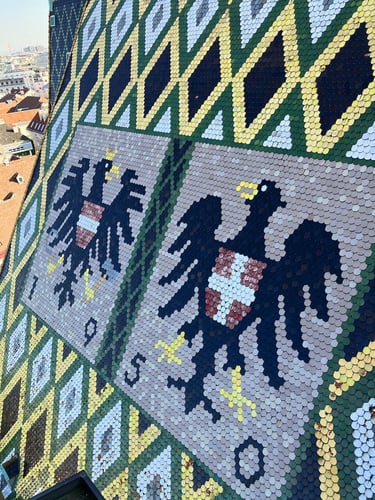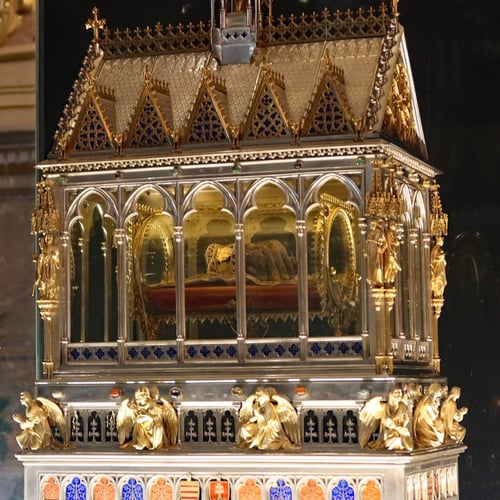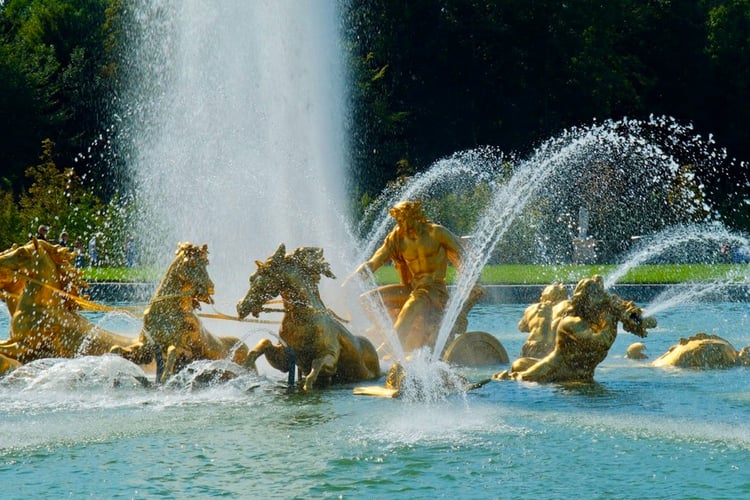St. Stephen's Cathedral Vienna: A Story of Resilience & Grandeur
St. Stephen’s Cathedral Vienna (also known as Stephansdom and Domkirche St. Stephan in German) undoubtedly stands out as a symbol of the Vienna's rich history, architectural grandeur, and spirit of resilience. With its soaring towers, intricate stonework, and vibrant tiled roof, this iconic Gothic masterpiece has been at the heart of Vienna for over eight centuries. During your visit to Austria's magnificent capital, and regardless of your faith, a visit to St. Stephen's Cathedral Vienna is a MUST!

St. Stephen's Cathedral Vienna: A Glimpse into History
The origins of St. Stephen’s Cathedral Vienna date back to the 12th century, when it was first consecrated as a modest parish church in 1147. It was built in the Romanesque style and actually located outside of the city's walls.
As Vienna grew in importance, so too did its church. Significant expansions and reconstructions took place in the 13th and 14th centuries, transitioning the structure from its Romanesque roots to the Gothic architecture that defines it today. Parts of St. Stephen's Cathedral Vienna's Romanesque roots are still visible today, including the main entrance - known as the Riesentor (the Giant's Door). One of the cathedral’s most iconic features, the South Tower (also known as Steffl or Stephansturm in German), was completed in 1433. The completion of the South Tower made St. Stephen’s the tallest building in Vienna for many centuries. The North Tower was not completed until 1578. The year 1578 is largely considered the year in which St. Stephen's Cathedral Vienna was finally completed.
The Roof: A Masterpiece of Design
The most striking feature of St. Stephen’s Cathedral Vienna is its roof, which is adorned with more than 200,000 glazed tiles arranged in a distinctive, colorful pattern. This intricate design includes the Habsburg coat of arms, the Viennese double-headed eagle, and the Austrian coat of arms, symbolizing the cathedral’s deep ties to the city’s imperial history. The roof’s vibrant colors and bold patterns are not just a visual marvel but also a reflection of the cathedral’s significance as a national symbol.

The roof’s steep pitch and large scale make it an engineering marvel, designed to withstand Vienna’s weather conditions. Due to the roof's steep slope, it is regularly cleaned by rain and rarely covered by snowfall. Its distinctive design and craftsmanship make the roof of St. Stephen’s one of the most recognizable elements of the Vienna skyline.

The Pummerin Bell and the Cathedral's Towers
Adding to the cathedral’s grandeur is its famous bell, the Pummerin, which hangs in the North Tower. Weighing around 21 tons, the Pummerin is one of the largest bells in Europe and has a history as resonant as its sound. The original Pummerin was cast from cannons captured from the Ottoman Turks during the failed siege of Vienna in 1683. Tragically, this bell was destroyed during a fire in 1945 in the final days of World War II. In 1951, the Pummerin was recast from the remains of the original bell and metal from the remaining captured Turkish cannons that were held at Vienna's Museum of Military History (Heeresgeschichtliches Museum). It was ceremonially reinstalled in the rebuilt North Tower the following year, in 1952. Today, its deep tones ring out across Vienna on special occasions including New Year's Eve, symbolizing the city’s resilience and enduring spirit.

You can see the Pummerin up close on a visit to the North Tower. The North Tower, standing at 223 feet (68 meters) tall is significantly shorter than the famous South Tower. However, the North Tower is far more popular with tourists since you can access it via elevator! The views from the top are incredible and while you can also see the Pummerin, our favorite part of visiting the North Tower was getting to see the beautiful roof tiles in greater detail.

The South Tower, known as the Steffl, is another key feature of St. Stephen’s Cathedral Vienna. Standing at 446 feet (136 meters), it remains the tallest point in Vienna's Innere Stadt. Visitors can climb the 343 steps to the top of the Steffl and enjoy breathtaking panoramic views of the city, showcasing the cathedral’s intricate roof and the sprawling cityscape below. While the views from the North Tower are pretty fantastic, anyone who has visited the South Tower will tell you that the views are far superior. Thanks to the South Tower's height, there are clear views in all four directions of the city. The South Tower is also less crowded since you only have the choice of climbing the stairs to reach the top and come back down again.
Interior Wonders & Artistic Masterpieces
Stepping inside St. Stephen’s Cathedral Vienna reveals a treasure trove of Gothic art and religious symbolism. The High Altar, completed in the mid-17th century, is a Baroque masterpiece that stands as the focal point of the cathedral’s interior. Richly adorned with sculptures and reliefs depicting the stoning of St. Stephen, the cathedral’s patron saint, the altar is a testament to the deep religious devotion and artistic skill of the time. Some of the cathedral's original stained glass can also be viewed behind the High Altar.

Another interior highlight is the Pulpit of St. Stephen’s. This intricately carved pulpit features figures of the Four Fathers of the Church (also called the Four Doctors of the Church) - St. Gregory the Great, St. Jerome, St. Augustine of Hippo, and St. Ambrose - and is renowned for its spiral staircase adorned with delicate, lace-like stonework. Beneath the staircase hides one of the most beloved features of St. Stephen's Cathedral: an enigmatic self-portrait of a sculptor, peering out from a window, a unique personal signature in this monumental work.


The cathedral’s numerous chapels, such as the Chapel of the Cross, and the elaborate Tomb of Emperor Frederick III are other notable features. The Chapel of the Cross, also called Kreuzkapelle in German, is located in the northeast corner of the cathedral. If you are facing the High Altar, the Chapel of the Cross is located to the left of the Giant's Portal. The Chapel of the Cross is the final burial place for Prince Eugene of Savoy, one of the greatest military leaders of his time. Unfortunately, the Chapel of the Cross is not open to the public, but it can be viewed through the gates.

On the other hand, the Tomb of Emperor Frederick III is easily accessible to the public. The The tomb, carved from red marble and adorned with 240 statues and reliefs, is one of Europe’s most impressive funerary monuments, reflecting the power and influence of Frederick III, who ruled the Holy Roman Empire for 53 years. The raised sarcophagus is located to the right of the High Altar.

Another beloved spot within St. Stephen's Cathedral Vienna is the Wiener Neustädter Altar which can be found to the left of the High Altar. The Wiener Neustädter Altar is technically a pentaptych with one main shrine panel and four additional side panels that move. The carvings of the Wiener Neustädter Altar are highly detailed and vibrant. Dating back to 1447, the altar is definitely worth a close look to appreciate its impressive craftsmanship.


Catacombs
The catacombs beneath the cathedral, also called the Stephansdom Crypt, offer a more somber glimpse into Vienna’s history. These underground chambers contain the remains of thousands of Viennese citizens, as well as members of the Habsburg dynasty. The catacombs also houses the Ducal Crypt which contains the urns of internal organs of several Habsburg rulers, in line with royal burial practices of the time. More information about the catacombs can be found on the Atlas Obscura website.
Please Note: If you are looking to see the elaborate tombs of the Habsburg rulers, you will want to visit the Capuchin Crypt Vienna (Kapuzinergruft).
Stained Glass Windows
St. Stephen’s interior is also known for its stained glass windows, which contribute to the ethereal atmosphere inside the cathedral. Although many of the original medieval stained glass windows were destroyed during the devastating fire that also destroyed the cathedral's roof at the end of World War II, the post-war replacements feature a modern, pastel color palette that add a contemporary vibrancy to the Gothic architecture. This new, modern stained glass is often referred to as being "Tupperware-colored." However, I personally adore the modern stained glass because of the light it brings to the space - filling the stone cathedral in beautiful hues of pastel light. In a way, it almost reminded me of a more toned-down version of the stained glass inside of the Sagrada Família in Barcelona, Spain. If you visit the cathedral on a sunny afternoon, the light streaming through the stained glass windows creates a dazzling display of colors that photos simply cannot capture.


Intriguing Details and Mozart’s Legacy
St. Stephen’s Cathedral Vienna is filled with fascinating details that offer a glimpse into its storied past. One such detail is the presence of self-portraits of the stonemasons who worked on the cathedral’s construction. These artisans carved their faces into the intricate stonework, leaving behind a personal legacy within the grand structure. While we have already discussed the portrait below the pulpit, there is one more that is hidden in plain sight. The portrait depicts Anton Pilgram, one of the cathedral builders of St. Stephen's Cathedral Vienna. He is connected to the pulpit and various sculptures within the cathedral. It can be found near the entrance to the North Tower (Pummerin), just be sure to look up!

The cathedral also has a strong connection to one of Vienna’s most famous residents, Wolfgang Amadeus Mozart. It was here that Mozart married Constanze Weber in 1782, and later, in 1791, his funeral was held at St. Stephen’s Cathedral Vienna. Although he was buried in a common grave at the St. Marx Cemetery, the cathedral remains closely tied to his legacy. The Pummerin bell, which tolled for his funeral, still rings out on special occasions, serving as a poignant reminder of Vienna’s rich musical heritage.
A plaque inside St. Stephen's Cathedral Vienna makes mention of its connection to Mozart, installed on the occasion of his 250th birthday, states the following (translated from German to English):
Wolfgang Amadeus Mozart and Constanze Weber were married on August 4, 1782 in their parish of St. Stephen. Their fourth child, Johannes, and their sixth child, Franz, were baptized in St. Stephen's Cathedral. After Mozart's death on December 5, 1791 - shortly before he was seeking the Kapellmeister (Director of Music) adjunct position at St. Stephen's and applied - the Requiem Mass was celebrated on December 6th and his body was blessed in the Chapel of the Cross.

Resilience Through History
While we have already mentioned that St. Stephen's Cathedral Vienna sustained significant damage at the end of World War II, that was not the first time the cathedral found itself in a city besieged by conflict. The failed Ottoman siege of Vienna in 1683 was a pivotal moment in European history, marking the beginning of the decline of the Ottoman Empire and the rise of Habsburg power in Central Europe. This event is particularly significant in Vienna’s history, as it not only shaped the city’s future but also quite literally left its mark on St. Stephen’s Cathedral Vienna.
Although St. Stephen’s Cathedral Vienna was not directly targeted during the siege, it still suffered some damage as a result of the conflict. The most notable incident was the embedding of a cannonball in one of the cathedral’s exterior walls. This cannonball, likely fired during the Ottoman bombardment of the city, remains lodged in the stone as a historical reminder of the siege. The presence of the cannonball serves as a tangible link to this dramatic period in Vienna’s history, symbolizing the city’s resilience and determination in the face of overwhelming odds.
Jetset Seeker Fun Fact: Either before you enter St. Stephen's Cathedral Vienna or after you exit the building, you have to play a game of "I Spy." There is a cannonball lodged into the exterior stonework of the cathedral! It dates back to the failed siege of Vienna in 1683 by the Ottomans. It is located in one of the middle buttresses near the South Tower. The date 1683 is inscribed above it. See if you can spot it!

While there are certainly other examples of the cathedral's resilience over time, we would be hard pressed not to further discuss the devastation it saw during World War II. In 1945, in the final days of the war, the cathedral was heavily damaged by fire. After surviving Allied bombing campaigns, a fire set to nearby buildings spread and caused the collapse of its wooden roof and destroyed much of the cathedral's interior. The rebuilding process was a monumental effort, taking nearly seven years, with the roof and many interior elements carefully restored to their former glory. Although, there were some modifications made to the design. First, the new roof was supported by steel since the original wooden framework was destroyed. The stained glass windows were also updated. The new stained glass windows, installed after the war, add a modern touch to the cathedral’s ancient walls, symbolizing Vienna’s ability to rebuild and renew.
The image below showcases the reconstruction of the roof of St. Stephen's Cathedral Vienna from 1945 to 1952.

St. Stephen's Cathedral Vienna: A Timeless Symbol of the City
St. Stephen’s Cathedral Vienna is more than just a church; it is a living monument to Vienna’s history, culture, and enduring spirit. Its breathtaking architecture, rich history, and intricate details make it one of the top Vienna attractions, drawing millions of visitors from around the world each year. Whether you are admiring the ornate roof from afar, marveling at the impressive stonework in the cathedral's interior, or taking in a bird's eye view of Vienna from one of its towers, St. Stephen’s Cathedral Vienna offers a profound connection to Vienna’s past and present, making it an essential stop on any visit to the Austrian capital.
How to Visit St. Stephen's Cathedral Vienna
Getting to St. Stephen's Cathedral Vienna
St. Stephen's Cathedral Vienna is located in Stephansplatz within the Innere Stadt neighborhood of Vienna. The nearest U-Bahn station is Stephansplatz and is serviced by the U1 and U3 lines.
Opening Hours & Admission Information
St. Stephen's Cathedral Vienna is open daily. Visiting hours for tourists are Monday through Saturday 9:00 AM to 11:30 AM and 1:00 PM to 4:30 PM. You can only visit St. Stephen's Cathedral on Sundays and public holidays from 1:00 PM to 4:30 PM. Tickets to enter the cathedral and its towers can be purchased on-site. If you are interested in the all-inclusive ticket for St. Stephen's Cathedral Vienna, which includes admission to the cathedral, South Tower, North Tower (Pummerin), a catacombs tour, a visit to the cathedral museum, and the Treasury of the Teutonic Order, tickets can be purchased online or at the cathedral. If you would like to purchase an all-inclusive ticket online, you can do so by visiting the Dom Museum Wien website. More information about ticket prices and visiting hours can be found on the St. Stephen's Cathedral Vienna website.
If you intend to explore both the cathedral and one of its towers, allocate approximately 90 minutes for your visit to St. Stephen's Cathedral Vienna. Most of the cathedral can be visited on your own; however, if you are interested in seeing the catacombs, a guided tour is required. Advance sign-up for the catacombs tour is not required and tours are frequent. Tours are available in both English and German. There is an additional cost to visit the catacombs. The catacombs tour typically lasts around 20 minutes.
Jetset Seeker Pro Tip: Rick Steves Audio Europe offers a fantastic (and free!) audio guide for St. Stephen's Cathedral Vienna. If you download the Rick Steves Audio Europe app for iPhone and Android, you can even download the audio tour to listen to it without WiFi or cellular service during your time at St. Stephen's Cathedral Vienna. The audio guide is 35 minutes in length when listened to straight-through, but you will likely want to pause the audio at various points as you make your way through the cathedral.
Please keep in mind that St. Stephen's Cathedral Vienna is still a place of worship, even outside of Mass times. As a result, hats, short skirts/dresses and shorts, and sleeveless tops are prohibited. It is important to dress modestly and appropriately to show respect.
Concerts
St. Stephen's Cathedral Vienna is not only a place of worship, but also a concert venue. Classical music concerts are regularly held at the cathedral and are open to the public. These concerts provide another opportunity to see this magnificent cathedral during your trip to Vienna. Advance tickets are required. The concerts typically last anywhere from 60 to 120 minutes, depending on the performance. Tickets start at €15. Additional information about the classical music concerts, as well as the upcoming schedule, and online ticket office can be found on the St. Stephen's Cathedral Vienna Concerts website.
Looking for even more information on Vienna and Austria? Check out our Vienna Travel Guide for details on neighborhoods, shopping, restaurants, and more. From money matters, to train information, and more, we have it all in our Austria Travel Guide. Have you visited Vienna or are you planning an upcoming trip? We would love to hear from you!
%20(1).png?width=3690&height=2079&name=Jetset%20Seeker%20Logo%20(Banner)%20(1).png)


